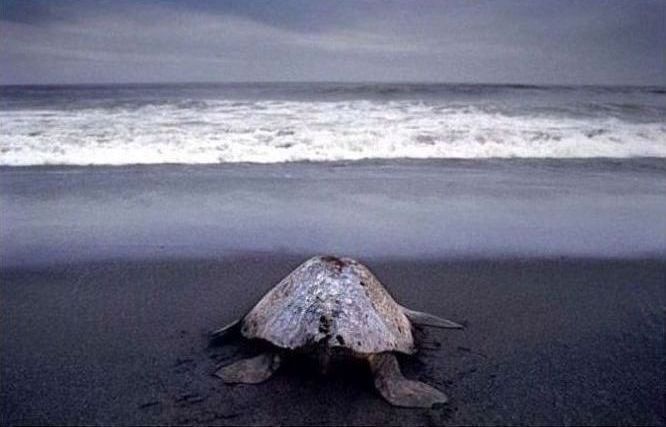Arribadas, Pacific Olive Ridley Sea Turtles Synchronised Nesting
|
• Threats
Known predators of olive ridley eggs include raccoons, coyotes, feral dogs and pigs, opossums, coatimundi, caimans, ghost crabs, and the sunbeam snake. Hatchlings are preyed upon as they travel across the beach to the water by vultures, frigate birds, crabs, raccoons, coyotes, iguanas, and snakes. In the water, hatchling predators most likely include oceanic fishes, sharks, and crocodiles. Adults have relatively few known predators, other than sharks, and killer whales are responsible for occasional attacks. Females are often plagued by mosquitos during nesting. Humans are still listed as the leading threat to L. olivacea, responsible for unsustainable egg collection, slaughtering nesting females on the beach, and direct harvesting adults at sea for commercial sale of both the meat and hides.
Other major threats include mortality associated with boat collisions, and incidental takes in fisheries. Trawling, gill nets, ghost nests, longline fishing, and pot fishing, have significantly affected olive ridley populations, as well as other species of marine turtles. Between 1993 and 2003, more than 100,000 olive ridley turtles were reported dead in Odisha, India from fishery-related practices. In addition, entanglement and ingestion of marine debris is listed as a major threat for this species. Coastal development, natural disasters, climate change, and other sources of beach erosion have also been cited as potential threats to nesting grounds. Additionally, coastal development also threatens newly hatched turtles through the effects of light pollution. Hatchlings which use light cues to orient themselves to the sea are now misled into moving towards land, and die from dehydration or exhaustion, or are killed on roads.
However, the greatest single cause of olive ridley egg loss results from arribadas, in which the density of nesting females is so high, previously laid nests are inadvertently dug up and destroyed by other nesting females. In some cases, nests become cross-contaminated by bacteria or pathogens of rotting nests. For example, in Playa Nancite, Costa Rica, only 0.2% of the 11.5 million eggs produced in a single arribada successfully hatched. Although some of this loss resulted from predation and high tides, the majority was attributed to conspecifics unintentionally destroying existing nests. The extent to which arribadas contribute to the population status of olive ridleys has created debate among scientists. Many believe the massive reproductive output of these nesting events is critical to maintaining populations, while others maintain the traditional arribada beaches fall far short of their reproductive potential and are most likely not sustaining population levels. In some areas, this debate eventually led to legalizing egg collection.
|
|









